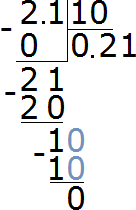Dividing a decimal by 10, 100, or 1000 is done in the same way as dividing a decimal by a whole number. For example, divide 2.1 by 10. Solve this example with a column division:

But there is a second way. It is easier. The essence of this method is that the point in the divisor is moved to the left by as many digits as there are zeros in the divisor.
Let's solve the previous example this way. 2,1 : 10. We look at the divisor. We are interested in how many zeroes are in it. We see that there is one zero. It means that in the divisor 2.1 we need to move the point to the left by one digit. We move the point to the left by one digit and see that there are no more digits left. In this case, we add another zero before the digit. As a result, we get 0.21
2.1 : 10 = 0.21
Let's try to divide 2.1 by 100. The number 100 has two zeros. So in the divisible 2.1 we have to move the point to the left by two digits:
2.1 : 100 = 0.021
Let's try to divide 2.1 by 1000. There are three zeros in the number 1000. So in the divisible 2.1 we have to move the point to the left by three digits:
2.1 : 1000 = 0.0021
2. If you find an error or inaccuracy, please describe it.
3. Positive feedback is welcome.